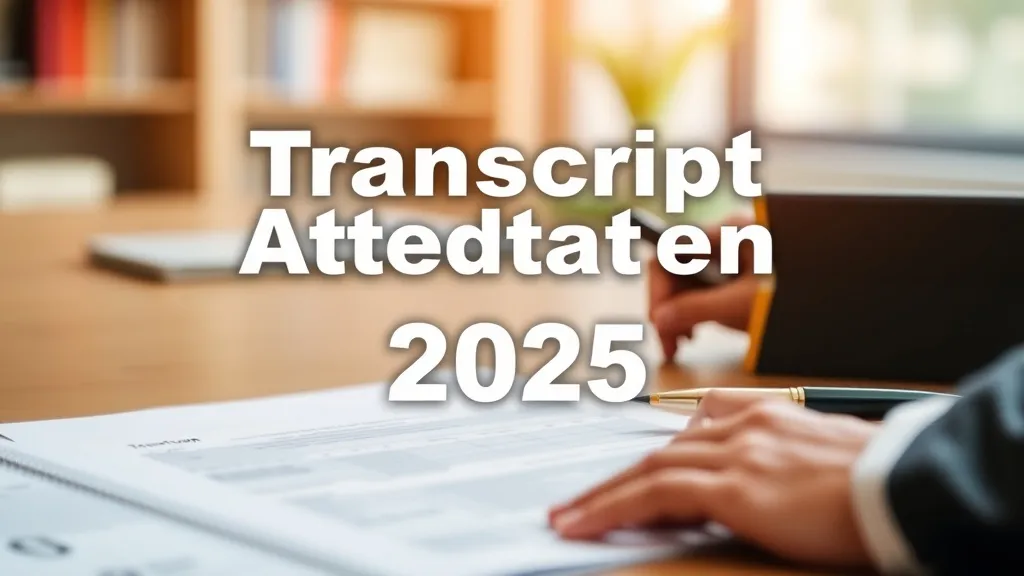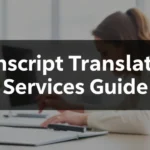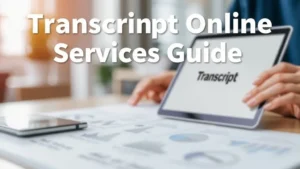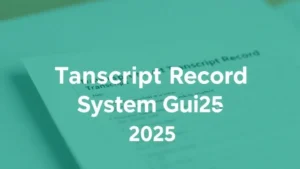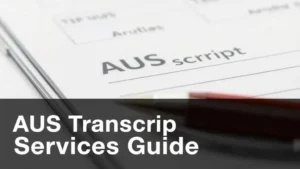Transcript Attestation Process 2025
You know how daunting it feels when you need transcript attestation before an international application? You’re not alone. 55% of study-abroad candidates report confusion over steps and timelines (source: ICEF). Here’s the thing: a smooth attestation can make or break your next opportunity. In this guide, you’ll learn precisely what transcripts are, why attestation matters, and exactly how to navigate the 2025 process. You’ll get insider tips on apostille vs embassy routes, a step-by-step walkthrough, and a peek at digital attestation trends. Ready for clarity? Let’s dive in.
Table of Contents
- What Is Transcript Attestation and Why It Matters
- Step-by-Step Transcript Attestation Process in 2025
- Apostille vs Embassy Attestation: Choosing the Right Path
- Digital Transcript Attestation: The Future is Now
- Common Mistakes and How to Avoid Them
- Advanced Tips for Smooth Attestation
- Future Trends in Transcript Attestation
- Frequently Asked Questions
- 1. What documents do I need for transcript attestation?
- 2. How long does apostille take in 2025?
- 3. Can I mail transcripts for embassy attestation?
- 4. Are digital attested transcripts accepted universally?
- Conclusion
What Is Transcript Attestation and Why It Matters
Hook: Ever wondered why your university seal alone isn’t enough?
In other words, you need an official stamp of legitimacy recognized worldwide. Transcript attestation is the formal process of verifying academic records by designated authorities. Without it, visas stall and admissions fall through.
Let me explain: attestation adds layers of authenticity—from your college registrar to state or national education boards, then on to embassies or apostille authorities. That chain confirms your documents are genuine.
“An apostille certifies the origin of a public document, easing cross-border use” —Wikipedia
Actionable takeaway: Check your institution’s registrar office first. Request sealed, signed transcripts at least six weeks before your deadline.
- Definition: Official verification of academic transcripts
- Purpose: Legal recognition for education or immigration
- Key Players: University registrar, state board, apostille/embassy
Step-by-Step Transcript Attestation Process in 2025
Hook: Ready for a clear roadmap?
Why this matters: Skipping steps leads to costly delays. Follow each stage carefully.
Here’s the stepwise guide (for most countries):
- Obtain sealed transcripts from your university.
- Authenticate at your state or national education board (Rs. 500–1,000; 1–2 weeks).
- Choose apostille (2–3 days) or embassy attestation (2–4 weeks; Rs. 1,000–5,000).
- Submit to destination country’s authority if required.
- Receive attested documents and confirm details.
Example: Priya from Mumbai completed university attestation and then an apostille in just 48 hours, saving her urgent Canada study visa processing time.
“Start requests 15–20 days before intake,” advises WES. That’s smart planning (WES).
Actionable takeaway: Book slots with your state board online. Watch out for peak season backlogs in July–September.
Apostille vs Embassy Attestation: Choosing the Right Path
Hook: Confused which route to pick?
Here’s the truth: apostille is faster and cheaper if your destination follows the Hague Convention. Embassy attestation, however, remains mandatory for non-Hague countries.
Consider these factors:
- Processing time: Apostille (2–3 days) vs Embassy (2–4 weeks).
- Cost: Rs. 2,000 average for apostille; Rs. 3,000–5,000 for embassy.
- Acceptance: Check the embassy’s website or the UK government portal for specifics.
Example: Students heading to Germany use apostille. Those bound for Qatar often need embassy signatures.
Actionable takeaway: Visit the destination country’s consulate website first—never assume.
Digital Transcript Attestation: The Future is Now
Hook: Who said paper is the only way?
Interestingly enough, Kathmandu University and Tribhuvan University rolled out digital transcripts in 2024. These electronic versions often come sealed with blockchain seals.
Advantages include instant delivery, lower loss risk, and easier sharing with bodies like WES or medical boards.
Expert data: 42% of universities worldwide plan full digital integration by 2026 (EduTech Report 2025).
Actionable takeaway: Ask your registrar if they offer e-attested transcripts. It can cut lead time by half.
Common Mistakes and How to Avoid Them
Hook: Avoid these pitfalls—and save weeks.
- Missing apostille pages: Ensure all sides of your documents get stamped.
- Wrong embassy: Some students go to consulates in other states—confirm your local office.
- Late requests: Crowd peaks cause 4-week delays.
Actionable takeaway: Create a checklist (Qualification Transcript Meaning 2025) and tick each item as you go.
Advanced Tips for Smooth Attestation
You might be wondering how to expedite even further?
Use courier services with tracking, prepare duplicate sets, and keep digital backups. (Just in case.)
Insider tip: Some professional boards require transcripts directly from institutions—plan for that if you’re in healthcare or law.
Actionable takeaway: Subscribe to email alerts from your embassy—changes happen fast.
Future Trends in Transcript Attestation
Forward-thinking universities are integrating credential wallets and blockchain verification. The bottom line is less paperwork, more automation.
In other words, you’ll soon show verified transcripts via apps instead of paper piles.
Actionable takeaway: Stay updated on your school’s tech roadmap; pilot programs often open to volunteers.
Frequently Asked Questions
1. What documents do I need for transcript attestation?
You need sealed transcripts, a copy of your passport, application forms, and processing fees.
2. How long does apostille take in 2025?
Typically 2–3 days, depending on your state authority’s workload.
3. Can I mail transcripts for embassy attestation?
Yes, but use a tracked courier and include self-addressed return envelopes.
4. Are digital attested transcripts accepted universally?
Not yet. Confirm with your target institution or immigration authority.
Conclusion
To summarize, transcript attestation transforms your papers into globally valid credentials. You’ve seen why it’s crucial, how to choose between apostille and embassy routes, and the rise of digital transcripts. Next steps: 1) Request sealed transcripts now. 2) Verify your destination’s requirements on official sites. 3) Follow a detailed Qualification Transcript Meaning 2025.
Embrace the process with confidence—your next academic or professional milestone awaits. Good luck with your transcript attestation journey in 2025!
